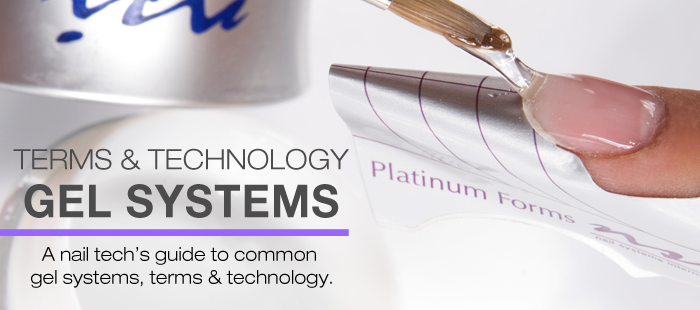WANT 20% OFF YOUR FIRST ORDER? SIGN UP NOW
Terms & Technology: Gel Systems

Let’s first point out the Myths
Acrylics are Chemicals and Gels are Not
This myth probably stemmed from the fact that acrylic liquid releases an odor and gels do not. Monomer’s odor is directly related to the evaporation rate of a particular ingredient (vapor caused by evaporation releases the odor). Gels do not have an evaporation rate, so there is no odor. Both Acrylic and Gels are Chemicals.
Gel products do not contain acrylic chemicals
Nothing can be further from the truth. Acrylate, is the main chemical in both products and is part of the word that forms acrylic. They are in FACT both acrylic. Acrylic powders are referred to as Meth-Acrylate and gels are referred to as Urethane Acrylate.
When gels were first introduced into the nail industry in the mid 80’s, the goal was to create a strong and durable enhancement parallel to acrylic, with a glossy, hard finish. The urethane acrylate oligomer base, chosen to create these gels, had a tight molecular structure, resulting in a lower molecular weight (meaning they feel lighter). This made them highly resistant to solvents (meaning that they don’t soak off).
What are Oligomers
Oligomers are short preformed chains of monomer that make up the chemistry of gels. The monomers in gel are already linked to form these chains. They are pre mixed for you so there is no mix ratio that you need to worry about. This also makes it quicker to cure with a UV or LED lamp in comparison to traditional acrylics needing up to 48 hours to fully harden.
Photo Initiators
UV and LED lights are the energy source needed for Photo Initiators (PI) to generate the free radicals for the curing process. In general, the more PI’s there are in a formula, the faster the cure. It is often, during this time of curing that heat spikes can be generated. The heat spikes come from the PI’s as they are creating energy while hardening.
It is very important for technicians to apply the gel in thin layers and do more layers to build up the proper enhancement, instead of one thick layer. It is also important to note that thick layers allow less light to reach the bottom layers, resulting in service breakdown and undercured product.
Using the proper photo initiators and the correct amount for a UV or LED gel are two of the most difficult tasks facing NSI scientists who formulate these types of products. Three of the most important factors in UV and LED curing are:
· A proper balance between the photo initiators and nail lamp.
· The intensity and the spectrum of available UV or LED light.
· The duration of the light exposure.
TERMINOLOGY
Oligomer – The backbone of gel chemistry is the urethane acrylate oligomer. It’s a short, pre-formed chain of individual monomers. In light-cured materials, urethane acrylate oligomers offer superior toughness and scratch resistance. They are the base for all gel and play a crucial role in determining the gel’s working properties, including how they are removed.
Gel Powder – In plain terms, it is acrylic powder used with a resin based dipping system. Some manufacturers advertise dip systems in this way to imply to customers it is a “healthy” alternative to gel polish.
UV/LED Gels – An oligomer-based nail product that requires UV/LED energy to cure. UV gels give the technician unlimited working time prior to curing in a UV/LED lamp. They are tough and durable, so suitable for virtually any type of service, including natural nail overlay, tip and overlay, or sculpting on a form. They are solvent resistant, so they must be filed off for removal.
Hard Gels – This is another name that describes a traditional gel enhancement that is solvent resistant. “Hard” may refer to the gel being non-porous and needing to be filed off for removal. Hard gels are sculpting gels and they can come in many different viscosities (meaning thicknesses). Hard gels cannot be soaked off, they must be filed off to remove.
Soft Gels or Removable Gels – These gels are an easy to remove alternative to traditional hard gels. Removable gels maintain many of the same characteristics of traditional hard gels, with the addition that they can be soaked off in Acetone to remove. Don’t let the word “removable” or “soft” give you the impression that they are not strong – Some removable gels are strong enough to use for sculpting enhancements.
Gel Polish – This term refers to a system of thin, light weight light-cured gels that are a longer lasting alternative to traditional air dry nail polish. Gel polish does add a slight layer of strength and protection to the natural nail but they cannot be used to sculpt with. Gel Polishes tend to last up to two weeks, and can be removed by soaking in Acetone. Gel Polish is traditionally packaged in a nail polish bottle that is completely opaque due to it’s light curability.
Gel Colour – Defined as a heavily-pigmented pure gel (without the presence of solvents) used for nail art or to cover the entire nail enhancement with colour. They can be used over either traditional acrylic or gel enhancements. Colour gels are traditionally packaged in a pot, rather than a polish bottle. This can be a distinguishing factor from a close relative: gel polish.
